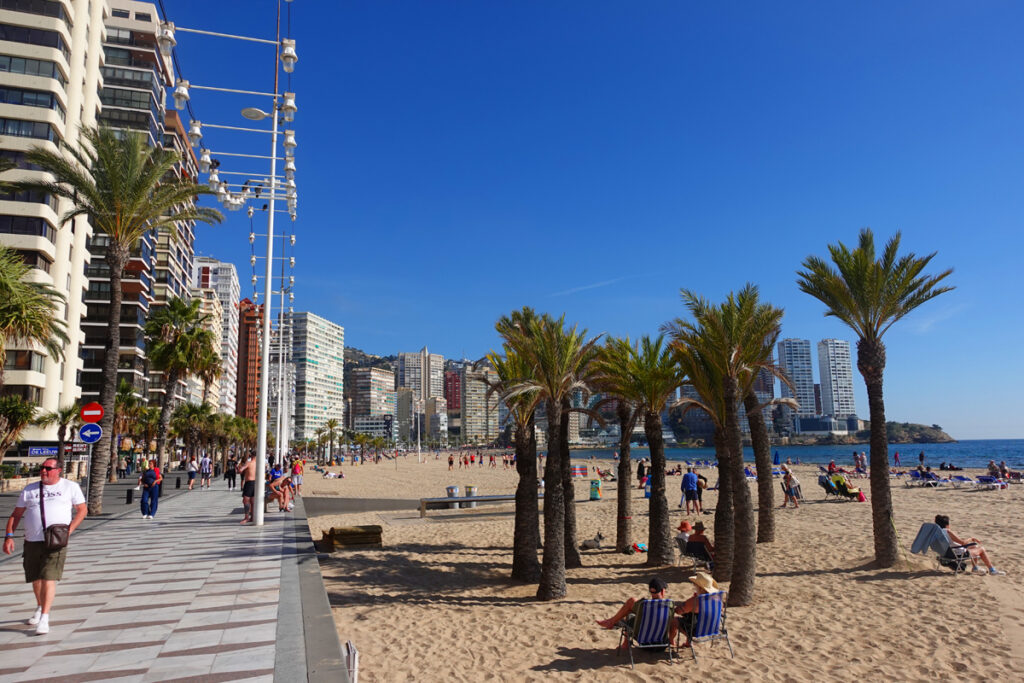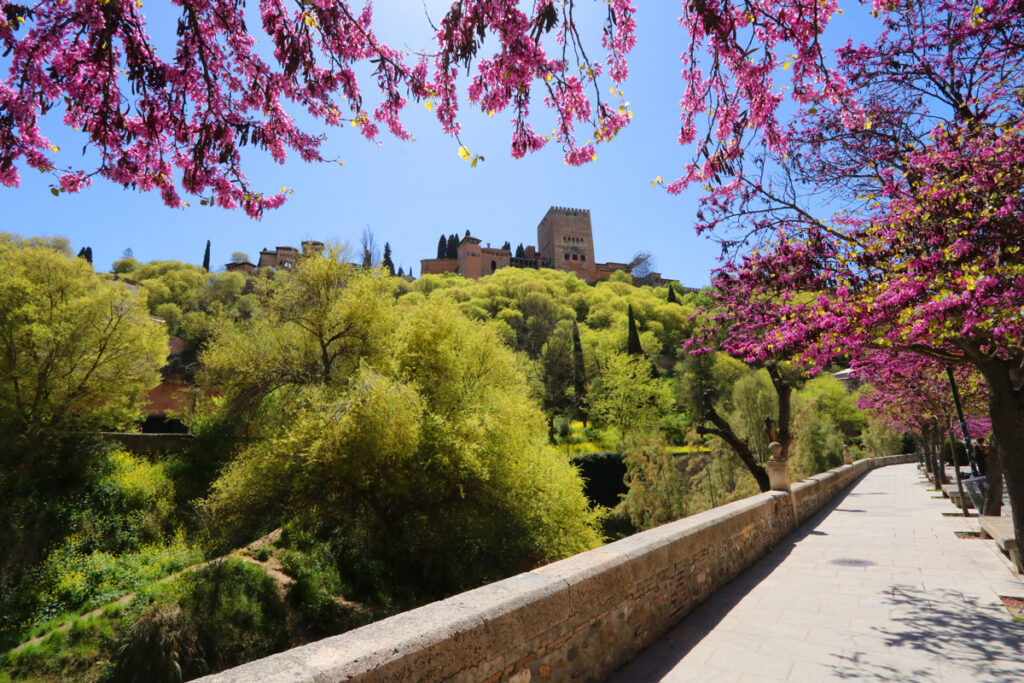Why Shoulder Season is the best time to Visit Spain.
Most travellers get Spain wrong. Many come in July and August where they suffer sweltering crowds and heat (I think the summer months are the absolute worst time to come to Spain). Others come in January or February which can have unpredictable weather. It’s also the time of year when many coastal towns are just too quiet.
The best time to visit Spain are during the shoulder seasons—spring (March to May) and autumn (September to November). Temperatures during these times normally range from 16°C to 26°C and the crowds haven’t yet descended on Spain, allowing you authentic local experiences and the breathing room you need to actually enjoy your holiday.
Spain-Holiday.com has conducted a study into places in Spain with the most pleasant weather during Spain’s shoulder season. These coincide with restaurant terraces being open (without requiring bookings) and famous historical sites not having hour-long lines. It’s also a time when flights cost less (statistically 22% lower than during high season) and accommodation is cheaper.
The Best Weather
Spain’s shoulder seasons offer the best weather to travellers. While summer temperatures regularly soar above 35°C in cities like Seville and Granada, shoulder seasons bring a bit of relief. Spring brings average temperatures of 16°C to 24°C, whilst autumn offers slightly warmer conditions at 18°C to 26°C across most regions.
The Mediterranean coastline provides Spain’s most reliable weather patterns during these periods because of the sea’s moderating influence. You’ll find stable, sunny conditions with occasional light rainfall—even if it rains it usually passes quickly to be replaced with sunny skies. Northern coastal areas like the Basque Country can experience spring showers but southern regions bask in predominantly sunny conditions.
Central Spain, including Madrid, have more pronounced seasonal variations, but the shoulder seasons smooth these extremes into comfortable ranges perfect for exploring the city. Madrid is much more enjoyable when not battling oppressive heat.

The Spanish Costas during Shoulder Seasons
Spain’s coastline transforms during shoulder season, revealing why locals consider these months the real peak travel time. The Costa del Sol earns its reputation as Spain’s most reliable destination, delivering spring temperatures of 16°C to 24°C and autumn warmth of 18°C to 26°C. Because of its latitude and Mediterranean influence, the Costa del Sol consistently has pleasant conditions perfect for both beach lounging and cultural exploration.
You won’t find yourself fighting for beach space in Marbella or Torremolinos during these months. Their famous beaches are busy enough but without the crowds of summer. You can visit places like Ronda and Malaga or do activities like the Caminito del Rey or the Torcal de Antequera without passing out from the heat. Similarly, if you’re a golfer you have perfect playing conditions.
According to the Spain-Holiday.com study, Valencia has pretty much an ideal balance between Spain’s northern and southern climates. Spring temperatures range between 14°C to 24°C and autumn between 15°C to 26°C. These are excellent temperatures, whether you want to explore the historic center or lounge at nearby Malvarrosa beach. Turia Park becomes a cycling and walking paradise during these temperate months.
The Costa Blanca, including Alicante and Benidorm, normally offers exceptional consistency with temperatures ranging from 15°C to 25°C during both shoulder seasons. This southeastern coastline provides some of Spain’s most predictable weather patterns, making it highly reliable for advance planning.

City Exploration during the shoulder seasons
Seville is the perfect example; temperatures in summer often exceed 35°C, making sightseeing not only uncomfortable but dangerous. During either shoulder season, temperatures are usually in the 16°C to 29°C range, making exploration a lot more enjoyable. You can visit the Alcázar and Seville Cathedral, and wander the historic Barrio Santa Cruz without having to constantly stop for cooling breaks. And some festivals are held during shoulder seasons – the Feria de Abril, for example, is one of Spain’s most popular festivals featuring horses, traditional carriages, and ladies wearing colourful flamenco dresses.
In Granada, the mountains of the Sierra Nevada create particularly pleasant shoulder season conditions. You’ll usually find temperatures in the 11°C to 27°C range during spring and autumn. It’s the best time to visit the Alhambra or explore the Albaicin without the extreme temperatures you get in summer.
Barcelona, in the northeast, has spring temperatures ranging from 14°C to 23°C and autumn temperatures in the 17°C – 25°C range. The city’s Mediterranean climate provides stable conditions throughout both shoulder seasons, though spring occasionally brings brief rainfall periods (with an emphasis on brief – rain usually passes quickly).

Why Timing is everything
I’ve mentioned cooler temps and cheaper prices (both airfares and accommodation are cheaper during shoulder season). But shoulder season travel also means less vacationers and smaller lines for popular sights like Granada’s Alhambra or Barcelona’s Sagrada Familia. So there are many reasons for shoulder travel.
In fact, Europeans familiar with Spain often come during shoulder season. While it may not coincide with most people’s holidays, they do so exactly because of both temperature and financial advantages. In fact, 42% of European visitors choose shoulder season to visit Spain, taking holidays ranging from 7 to 12 nights. And the trend is growing with the increased flexibility of travellers and the effects of climate change. The numbers reflect that shoulder season travel is increasingly growing as absolutely the best time to visit Spain.
Related: Spain’s Top Historic cities (that you should visit)


For December -February I would personally rather experience a snowy place, maybe landlocked central and/or alpine Europe or northern Scandinavia (although it can get too dark in the winter ). If one wants warmer climate inside Europe this period I would recommend Madeira.
Totally agree with everything you say RJA. It is June 1, it is 35C in Granada and f*ing miserable. and it only gets worse…walking around sightseeing in summer is torture, just unbearable. We used to say the same when we lived in Croatia and heard of tourists dying of sun stroke…but it gets even hotter here in Spain.
Madeira and the Azores high on my list of places to see in the near future.
I’ve never understood why people visit southern Europe in the summer. Southern Europe is great March-May and September-November as you say, while I would recommend Scandinavia/The Baltics/Northern Germany and Poland/UK/Benelux for June-August.